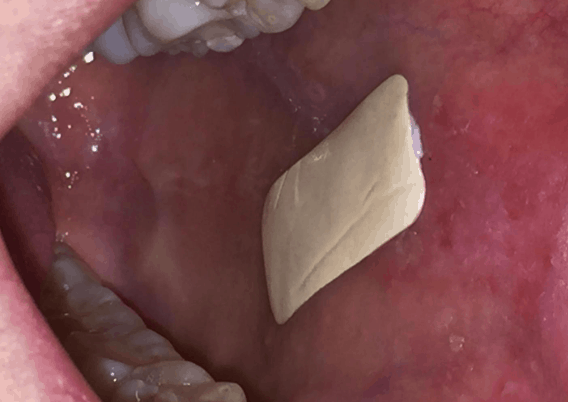Electrospun patches adhere inside the mouth to treat ulcers
UK researchers have used electrospinning to create biodegradable bandages that stick to the mouth and release drugs to treat ulcers.

(Credit: University of Sheffield)
The patches were developed by scientists from Sheffield University’s School of Clinical Dentistry working with Danish firm Dermtreat A/S. Currently, ulcers and lesions inside the mouth are largely treated using ointments or mouthwashes, which are not effective at targeting a specific area. This new treatment releases steroids directly to oral ulcers or lesions whilst also creating a protective barrier around the affected area.
The researchers made their ‘mucoadhesive’ patch using a process known as electrospinning, whereby polymers, solvents and other molecules are combined in ways that allow the resulting structures to be tuned. It’s a manufacturing technique that enables both nano- and microscale fibres to be interwoven, creating a high porosity and surface area that enables drugs to interact with the mouth, while also adhering to it.
Specifically, the patch created by the Sheffield team consisted of an outer hydrophobic polycaprolactone (PLC) backing layer and an inner, mucoadhesive component formed by electrospinning polyvinylpyrrolidone (PVP) and Eudragit RS100 as fibre-forming polymers. The work is published in the journal Biomaterials.
Register now to continue reading
Thanks for visiting The Engineer. You’ve now reached your monthly limit of news stories. Register for free to unlock unlimited access to all of our news coverage, as well as premium content including opinion, in-depth features and special reports.
Benefits of registering
-
In-depth insights and coverage of key emerging trends
-
Unrestricted access to special reports throughout the year
-
Daily technology news delivered straight to your inbox










Water Sector Talent Exodus Could Cripple The Sector
Well let´s do a little experiment. My last (10.4.25) half-yearly water/waste water bill from Severn Trent was £98.29. How much does not-for-profit Dŵr...